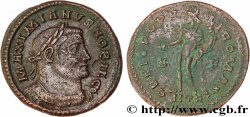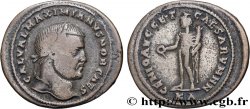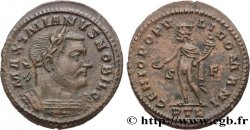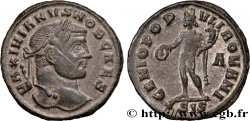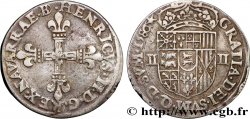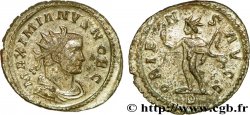v41_1126 - GALERIO Aurelianus
MONNAIES 41 (2009)
Precio de inicio : 350.00 €
Valoración : 700.00 €
lote sin vender
Precio de inicio : 350.00 €
Valoración : 700.00 €
lote sin vender
Tipo : Aurelianus
Fecha: 294
Nombre del taller / ciudad: Gaule, Lyon
Metal: vellón
Milésimas de pureza : 50 ‰
Diámetro: 23 mm
Eje de acuñación: 6 h.
Peso: 3,86 g.
Grado de rareza: UNIQUE
Officine: 2e
Emission: 12e
Comentarios sobre el estado de conservación:
Exemplaire sur un flan très large ovale et bien centré. Très beau portrait. Frappe molle et flan légèrement taché au revers. Patine grise avec des reflets métalliques
N° en los catálogos de referencia :
Anverso
Titulatura del anverso: MAXIMIANVS NOB C.
Descripción del anverso: Buste radié, drapé et cuirassé de Galère César à droite, vu de trois quarts en avant (A).
Traducción del anverso: “Maximianus Nobilissimus Cæsar”, (Maximien très noble césar).
Reverso
Titulatura del reverso: ORIE-N-S - AV-GG/ -|-// D.
Descripción del reverso: Sol (le Soleil) radié et nu debout à gauche, le manteau flottant sur l'épaule, levant la main droite et tenant un fouet de la gauche.
Traducción del reverso: “Oriens Augustorum”, (L’Orient des augustes).
Comentario
Avec l’intégralité de son argenture superficielle. Rubans de type 3 aux extrémités bouletées. Ptéryges invisibles sous le paludamentum. Sur cet exemplaire, nous semblons voir un D à l’exergue pour la quatrième officine. Mais Lyon ne fonctionne alors qu’avec trois officines. Se pourrait-il qu’une quatrième officine ait fonctionné ? C’est possible, mais peu probable. Notre D ressemble un peu à celui de l’exemplaire du Staatliche Museen de Berlin, Bastien n° 642b, pl. XLV. Mais si ce n’est pas le cas, il faudra pouvoir expliquer ce D à l’exergue de ce revers : ouverture d’une quatrième officine ou méprise d’un scalptor distrait ?.
With all of its surface silvering. Type 3 ribbons with rounded ends. Pteryges invisible under the paludamentum. On this example, we seem to see a D in the exergue for the fourth pharmacy. But Lyon then only operated with three pharmacies. Could it be that a fourth pharmacy operated? It's possible, but unlikely. Our D looks a bit like the one in the example from the Staatliche Museen in Berlin, Bastien no. 642b, pl. XLV. But if this is not the case, we will have to be able to explain this D in the exergue of this reverse: opening of a fourth pharmacy or mistake by an absent-minded scalper?
With all of its surface silvering. Type 3 ribbons with rounded ends. Pteryges invisible under the paludamentum. On this example, we seem to see a D in the exergue for the fourth pharmacy. But Lyon then only operated with three pharmacies. Could it be that a fourth pharmacy operated? It's possible, but unlikely. Our D looks a bit like the one in the example from the Staatliche Museen in Berlin, Bastien no. 642b, pl. XLV. But if this is not the case, we will have to be able to explain this D in the exergue of this reverse: opening of a fourth pharmacy or mistake by an absent-minded scalper?








 Informar de un error
Informar de un error Imprimir la página
Imprimir la página Comparte mi selección
Comparte mi selección Haz una pregunta
Haz una pregunta Consignar / vender
Consignar / vender
 Descriptivo
Descriptivo